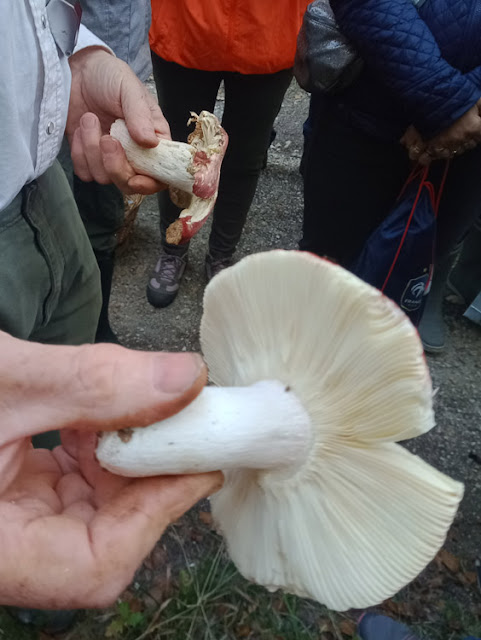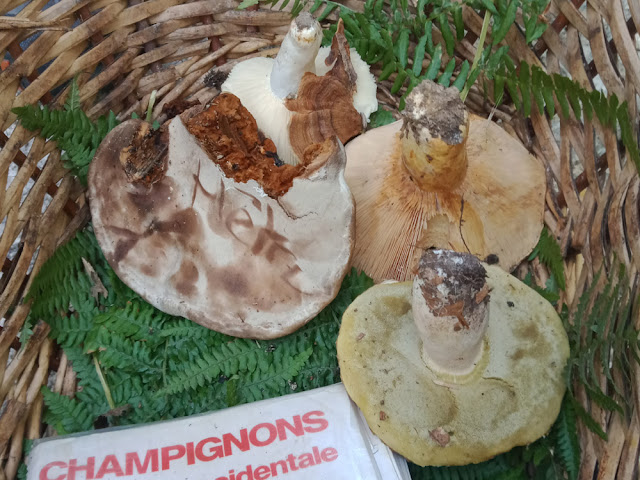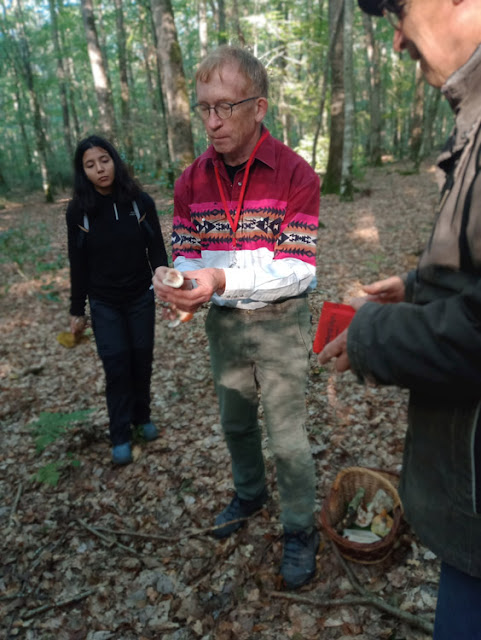October is normally when the most abundance of fungi can be found in the Touraine Loire Valley. The Carrefour de l'inspecteur is an intersection of half a dozen forest rides right in the middle of the Forest of Loches. Didier Raas led a fungi foray on behalf of the Association de botanique et de mycologie to Sainte Maure de Touraine, in partnership with the Tourist Office of Loches. The fungi was showing the effects of the dry weather, but we found a reasonable number of species.
A selection of toxic mushrooms, including Brown Rollrim Paxillus involutus (Fr. Paxille enroulé), Panthercap Amanita pantherina (Fr. and Oldrose Bolete Imperator rhodopurpureus (Fr. Bolet Vieux Rose).
Didier talking about Scarlet Brittlegill Russula pseudointegra (Fr. Russule coccinée). Rather rare and tastes unpleasantly of horseradish.
Spindleshank mushroom Gymnopus fusipes (Fr. Souchette), syn. Collybia fusipes. Abundant, growing in clumps on fallen logs, with tough stipes (stems) that become distorted with age.
Participants of these outings often take reference photos of mushrooms they particularly want to remember. This one is the edible Red Capped Scaber Stalk Leccinum aurantiacum (Fr. Bolet Orangé des chenes).
A bracket fungus (polypore), left, annotated with the name of the tree species it was found on, as an aid to identification. "Hetre" is beech. The fungus turned out to be Horse's Hoof Fomes fomentaria (Fr. Amadouvier). Also in the basket is Scarlet Brittlegill (top), Lactarius zonarius (Fr. Lactaire zoné), right, both tasting unpleasantly of strong horseradish, and at the bottom, Iodine Bolete Hemileccinum impolitum (Fr. Bolet dépoli).
Mycology expert Didier Raas talking about a cep (porcini).
Didier talking about Bare-toothed Brittlegill Russula vesca (Fr. Russule comestible), which conveniently for an edible mushroom, is ham coloured.
Blusher Amanita rubescens (Fr. Amanite rougissante), eaten by experienced fungi foragers, but one of the tricky Amanita genus, which includes many toxic species.
Sooty Milkcap Lactarius fuliginosus (Fr. Lactaire enfumé), found throughout the Northern Hemisphere in deciduous forests.
The edible species Scarletina Bolete Neoboletus erythropus (Fr. Bolet a pied rouge), showing the crucial lack of a fine red line between the flesh and the tubes, which would mean it was a different, toxic, species.
Beech Tarcrust Biscogniauxia nummularia (Fr. Hypoxylon nummulaire), a species which becomes more abundant in times of drought stress on the host tree, Beech.












No comments:
Post a Comment